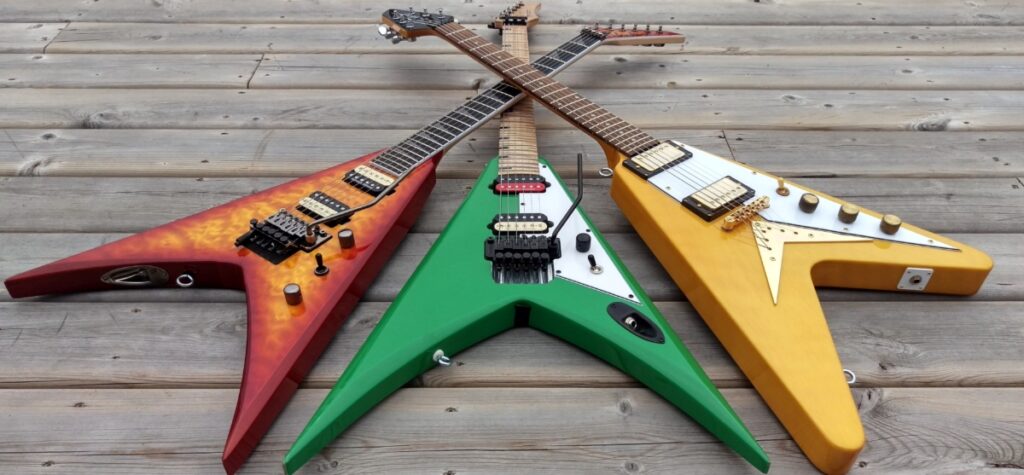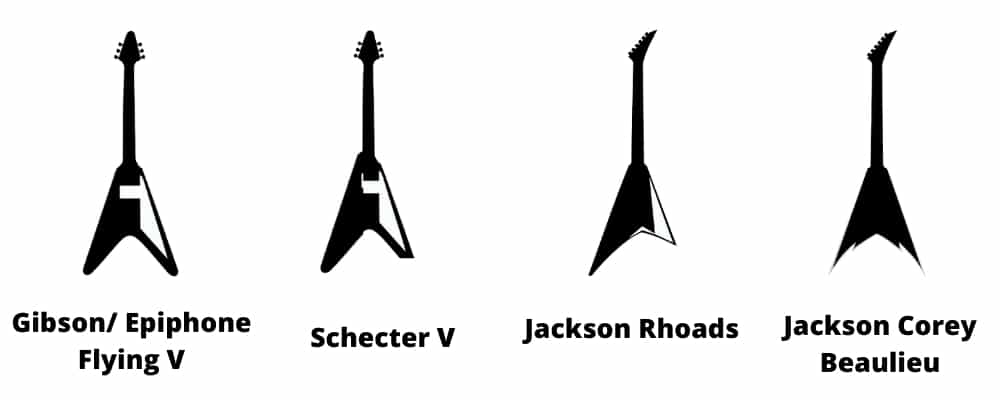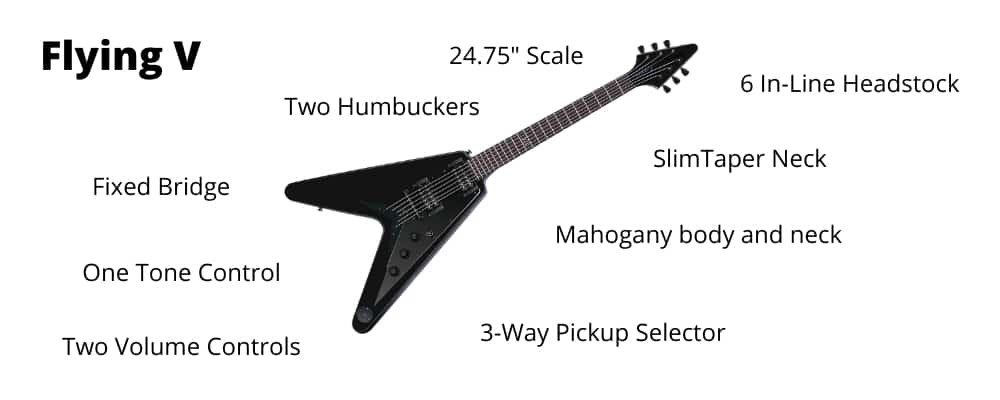The Flying V is an iconic electric guitar originally designed by Gibson, however plenty of brands now make V-shaped electric guitars as well. In this article, I’ll talk through the key design features of the Flying V, the signature tone, how easy it is to play, and go through the main ranges so you can identify the best options in your budget.
What is a Gibson Flying V?
The Gibson Flying V was first released in 1958. It has two humbucker pickups, a mahogany body and neck, fixed bridge, 22 frets and a 24.75″ scale length. The unique V-shaped guitar has a rich and full tone with a lot of sustain, making it a popular choice for metal and rock players.

Key Features
To get an idea of what makes a classic Flying V, let’s take a look at the specifications of the standard Gibson model. I’ll go through some more brands and types later in the article.
| Feature | Flying V |
| Body Shape | V-shape |
| Body Wood | Mahogany |
| Pickups | Two Humbuckers |
| Neck Shape | Slim Taper |
| Neck Wood | Mahogany |
| Neck Finish | Gloss |
| Construction | Set-Neck |
| Frets | 22 |
| Fretboard Wood | Rosewood |
| Scale Length | 24.75” |
| Bridge | Fixed |
| Volume Controls | 2 |
| Tone Controls | 1 |
| Pickup Selector | 3-way |
Types of V-Shape Electric Guitars
As well as the Gibson and Epiphone Flying V-range, there are also a few other brands that produce V-shape guitars.
Some of the most popular models are:
- Jackson Rhoads: pointy design with one longer side.
- Schecter V: rounded design with one slightly longer side.
- Jackson Corey Beaulieu: aggressive pointed design with barb on both sides.
- ESP Arrow: pointed design with one side longer than the other and a curve in the middle.

What Does Flying V Sound Like?
Let’s take a look at the Gibson Flying V to answer this question.
The Flying V has a thick and full tone due to the two humbucker pickups and mahogany tone woods. It has quite a dark and rich tone that particularly excels when using high gain, making it a popular choice for classic rock and metal. The set-neck construction also provides it with very good resonance and sustain.
Here are the main design features that help to characterise the Flying V tone:
- High-output dual-humbucker pickup configuration (BurstBucker pickups) makes it sound loud and aggressive
- Mahogany neck and body gives it a dark tone
- Set neck construction provides good levels of sustain
Here is a video to demonstrate the tone of the different pickups, using clean and distorted amp settings.
Music Styles
The Flying V is commonly used for classic rock and metal due to its punchy and heavy tone which sound great when using distorted amp settings. The aggressive body design also lends it well to the metal and glam rock genres as it is very much a statement guitar when used on stage.
Compared to a Les Paul?
The Flying V usually sounds a bit cleaner and snappier than the Les Paul which sounds more mellow. This is why a lot of players like the Flying V for lead playing as the natural EQ balance allows you to cut through the sound of the band slightly more easily than with a Les Paul.
Compared to an SG?
The Flying V and SG are similar sounding guitars due to their humbucker pickups, mahogany body wood and similar weights. The Flying V is slightly brighter sounding than the SG which has more low-end when using the bridge pickup, however it is very hard to tell the difference when using the middle and neck pickup positions.
Controls
Traditional Gibson and Epiphone explorers have 4 controls on the body:
- 3-way pickup selector allowing you to select either the neck or bridge pickup alone, or in isolation.
- Two volume controls (one for each pickup)
- A single tone control which adjusts both pickups
These controls are pretty basic, but the 3-way selector and independent volume controls for each pickup does allow you to blend the bridge and neck pickup for a unique tone, or switch from lead to rhythm style playing very quickly.

How Do They Feel to Play?
One of the biggest concerns people have about V-shape guitars, is playability. Since the shape is very dramatic and does not feature a waist, the sitting position in particular is quite different to standard guitar shapes.
Positives:
- Very good upper fret access
- Slim neck is comfortable for most players
- Standard scale length is suitable for most guitarists
- Balanced shape means the guitar is not “neck-heavy”
- Lightweight design makes it easy to stand for long periods
Negatives:
- You cannot rest your strumming arm on the upper bout like on most guitar shapes
- Can be uncomfortable to use whilst sat down and forces you to change your position
Sitting Down?
To play a V-shape guitar sat down, you can adopt the classical sitting position where your thigh rests in the centre of the V and the headstock is tilted upwards at around 45 degrees. Alternatively, you can sit normally but wear the guitar strap very short so it sits higher up without resting on the leg.
For Beginners?
A V-shape guitar is not usually chosen for beginners because it can be quite uncomfortable to sit with, which is the usual position beginners play in to practice. They are also quite expensive compared to most other entry-level guitars making them a less suitable option for new players.
But if you’re a new player and your heart is set on a Flying V, then just make sure you sit with one in a guitar store and see if it feels manageable compared to some more classically shaped guitars such as the Les Paul or Strat, because you may have a better experience with one of those shapes when you’re first getting to grips with the instrument.
Who Makes Flying Vs?
Gibson and Epiphone make the classic Flying V, so I wanted to take a look at their full range to show you the features and prices of the different models currently available. The prices are all based on Guitar Center at the time of writing, and the table is ordered from the lowest to the highest price.
| Model | Origin | Pickups | Finish | Colours | Price |
| Epiphone Flying V | China | ProBucker | Gloss | Black | $600 |
| Epiphone Flying V Prophecy | China | Fishman | Aged Gloss | Black, Yellow Tiger | $900 |
| Gibson Flying V B-2 | America | Dirty Fingers | Satin | Black | $1400 |
| Gibson Flying V | America | BurstBucker | Gloss | Antique Natural | $1700 |
| Gibson ‘70s Flying V | America | 70’s Tribute BurstBucker | Nitrocellulose lacquer | White | $2000 |
| Gibson Flying V Custom | America | Proprietary Humbucker | Nitrocellulose lacquer | Black | $4700 |
| Gibson Custom 1958 Flying V Reissue | America | Custombucker | Nitrocellulose lacquer | Walnut | $5000 |
| Gibson Custom 1967 Flying V Reissue | America | Proprietary Humbucker | Nitrocellulose lacquer | Red and White | $5000 |
Other V-Shape Guitars
There are also a few other brands which make V-shape guitars in addition to Gibson and Epiphone including: Jackson, Dean, Schecter and ESP. Here is a table showing the key features. All the models have two humbucker pickups.
| Feature | Schecter V-1 | ESP E-II Arrow | Jackson Rhoads | Dean V Select |
| Body Wood | Mahogany | Alder | Alder | Mahogany |
| Neck Shape | Slim Taper | Thin U | C-shape | V-shape |
| Neck Wood | Mahogany | Maple | Maple | Mahogany |
| Neck Finish | Satin | Gloss | Gloss | Satin |
| Construction | Set-Neck | Neck-through | Neck-through | Set-through |
| Frets | 22 | 24 | 22 | 22 |
| Scale Length | 24.75” | 25.5” | 25.5” | 24.85” |
| Bridge | Fixed | Floyd Rose | Fixed | Floyd Rose |
| Volume Controls | 2 | 1 | 2 | 2 |
| Tone Controls | 1 | 1 | 1 | 1 |
| Coil Tap | Yes | No | No | No |
Here are some images of each guitar type, each of them link to Amazon so you can check the current price of the models shown.
Brief History of the Flying V
- The Flying V was first made by Gibson in 1958, the same year as the Explorer was made.
- It was originally made from korina, but today’s models are made from mahogany.
- Production of the original model stopped in 1959, but the model was reissued in 1967 with a stop bar tailpiece instead of a string-through design.
- The Flying V2 was released in 1978 which featured “boomerang pickups” instead of humbuckers, which were designed to sound like single coils. This model was discontinued in 1982.
Who Played Them?
The Gibson Flying V has famously been played by Jimi Hendrix, Eddie Van Halen, Keith Richards, Tom Petty, Lenny Kravitz, James Hetfield and Kirk Hammet.
Guitar Center are always the first place I look at when I’m interested in a new electric guitar because have a huge range of models for sale and always have some excellent deals on. Here’s a link to take you directly to Guitar Center’s electric guitar range so you can see all the offers available at the moment.
Here are some more articles you might enjoy:




